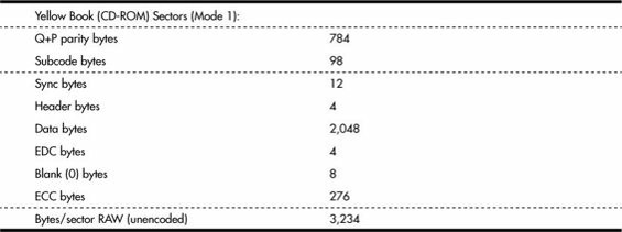Hardware Reference
In-Depth Information
Orange Book
The Orange Book defines the standards for recordable CDs and was announced in 1989 by Philips
and Sony. The Orange Book comes in three parts. Part I describes a format called CD-MO (magneto-
optical), which was to be a rewritable format but was withdrawn before any products really came to
market. Part II (1989) describes CD-R, and Part III (1996) describes CD-RW. Note that originally
CD-R was referred to as CD-WO (write-once), and CD-RW originally was called CD-E (erasable).
The Orange Book Part II CD-R design is known as a WORM format. After a portion of a CD-R disc
is recorded, it can't be overwritten or reused. Recorded CD-R discs are Red Book and Yellow Book
compatible, which means they are readable on conventional CD-DA or CD-ROM drives. The CD-R
definition in the Orange Book Part II is divided into two volumes. Volume 1 defines recording speeds
of 1x, 2x, and 4x the standard CD speed; the last revision, dated December 1998, is 3.1. Volume 2
defines recording speeds up to 48x the standard CD speed. The latest version released, 1.2, is dated
April 2002.
Orange Book Part III describes CD-RW. As the name implies, CD-RW enables you to erase and
overwrite information in addition to reading and writing. The Orange Book Part III CD-RW definition
is broken into three volumes. Volume 1 defines recording speeds of 1x, 2x, and 4x the standard CD
speed; the latest version, 2.0, is dated August 1998. Volume 2 (high-speed) defines recording speeds
from 4x to 10x the standard CD speed; the latest version, 1.1, is dated June 2001. Volume 3 (ultra-
speed) defines recording speeds from 8x to 32x; the latest version, 1.0, is dated September 2002.
Besides the capability to record on CDs, the most important feature instituted in the Orange Book
specification is the capability to perform multisession recording.
Multisession Recording Overview
Before the Orange Book specification, CDs had to be written as a single session. A
session
is defined
as a lead-in, followed by one or more tracks of data (or audio), followed by a lead-out. The lead-in
takes up 4,500 sectors on the disc (1 minute if measured in time or about 9.2MB worth of data). The
lead-in also indicates whether the disc is multisession and what the next writable address on the disc
is (if the disc isn't closed). The first lead-out on a disc (or the only one if it is a single session or
Disk At Once recording) is 6,750 sectors long (1.5 minutes if measured in time or about 13.8MB
worth of data). If the disc is a multisession disc, any subsequent lead-outs are 2,250 sectors long (0.5
minutes in time or about 4.6MB worth of data).
A multisession CD has multiple sessions, with each individual session complete from lead-in to lead-
out. The mandatory lead-in and lead-out for each session do waste space on the disc. In fact, 48
sessions would literally use up all of a 74-minute disc even with no data recorded in each session!
Therefore, the practical limit for the number of sessions you can record on a disc would be much less

